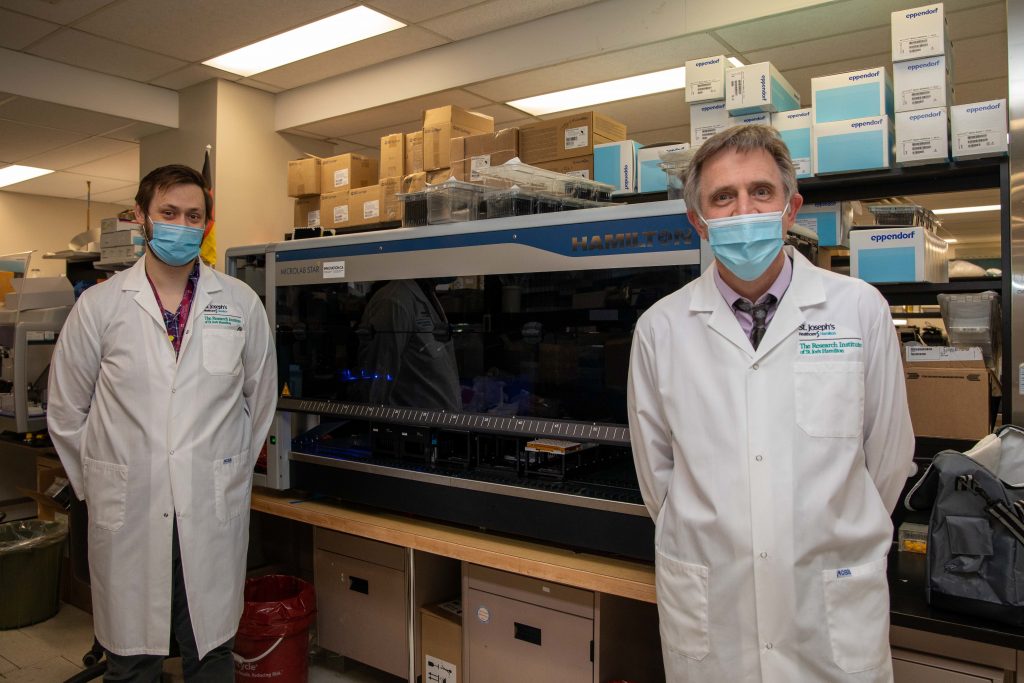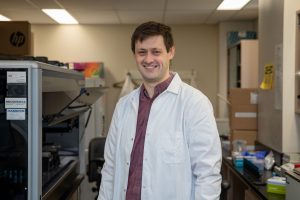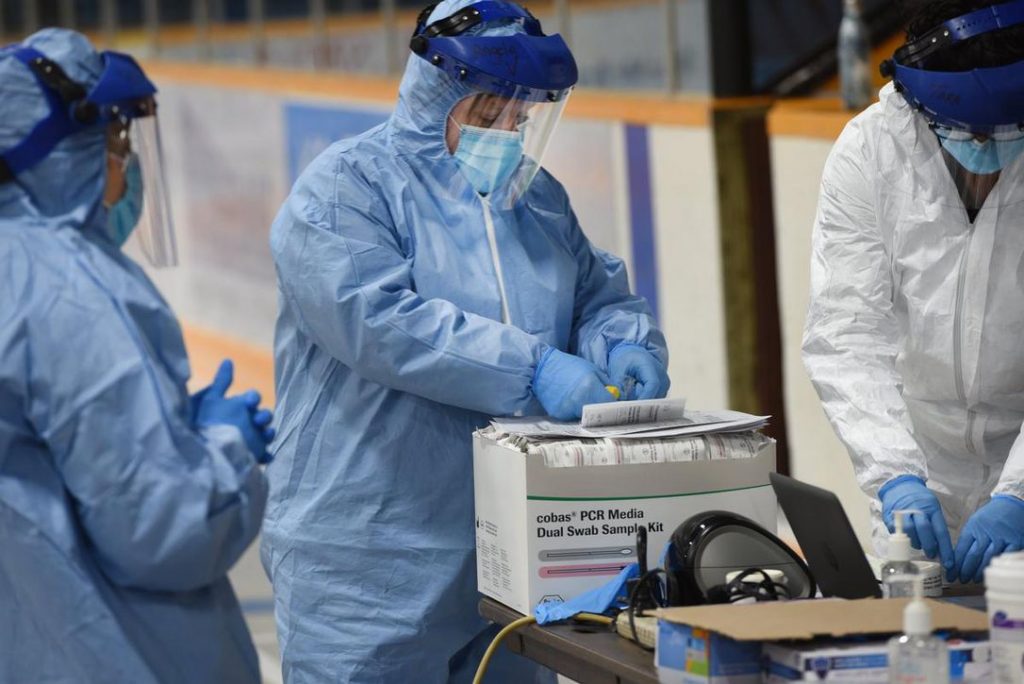HAMILTON, ON (May 21, 2020) – Scientists at The Research Institute of St. Joe’s Hamilton have developed entirely novel COVID-19 testing methods, which will allow for a significant increase in testing capacity across the province.
The new methods are being implemented in the Hamilton Regional Laboratory Medicine Program (HRLMP) – a partnership between St. Joseph’s Healthcare Hamilton and Hamilton Health Sciences – which is responsible for conducting clinical COVID-19 testing for the region. Currently, the HRLMP clinical testing capacity is 800 samples per day. With these advancements in place, scientists are aiming to test up to 6,000 samples daily.
Dr. David Bulir and Dr. Marek Smieja, infectious disease physician-researchers from St. Joe’s Disease Diagnostics and Development (D3) Group, predicted the need for an alternative supply of testing materials in January.
“In the face of global shortages, we’ve had to secure a new supply of all the materials required for COVID-19 testing, as well as invent some components that enable mass testing,” said Dr. Gail Martin, Executive Director of The Research Institute of St. Joe’s Hamilton. “St. Joe’s has effectively rebuilt and secured an entire supply chain, one that is urgently needed to manage the shortage of testing supplies.”
While some materials have been sourced and validated from new suppliers, such as flocked swabs and specimen tubes, other materials, including the new transport medium, are entirely novel. Dr. David Bulir developed the new transport medium and an enhanced test for COVID-19 at St. Joe’s research laboratory.
One of the key benefits of using these new testing materials with Dr. Bulir’s newly developed COVID-19 test is the ability to pool specimens. Specimen pooling can enable labs to increase their testing capacity up to fourfold, and potentially more. Since most tests produce negative results, only pools that come back with positive results will need to be further examined.
Building up the province’s stockpile of testing supplies and its capacity to perform rapid testing are vital as municipalities gradually lift lockdown restrictions.
“We’re working with the province to ensure we can rapidly develop ways to provide these new materials to other labs,” said Dr. Martin. “This is a Made-in-Ontario solution to a critical global shortage.”
This project will have a significant impact on the increased testing that will be needed to emerge from COVID-19, the value of which has been demonstrated through the Surveillance Pilot Project, launched in collaboration with St. Joseph’s Health System. That project aimed to detect the spread of COVID-19 and determine the most effective testing strategies in long-term care and congregate settings.
Development of these innovative testing methods could not have been possible without the support and funding from the Juravinski Research Institute, the Ontario COVID-19 Rapid Research Fund, St. Joseph’s Health System, and The Research Institute of St. Joe’s Hamilton.
Premier Doug Ford announced the Ontario COVID-19 Rapid Research Fund projects at a press conference Thursday afternoon, expressing his enthusiasm for the St. Joe’s project.
Background Info:
Shortage of testing supplies
- Due to factory closures in Italy where the gold-standard flocked swabs and transport media are produced, as well as stockpiles that were not maintained at pandemic-level quantities by manufacturers, standard testing supplies are scarce.
- St. Joe’s researchers designed a new supply chain to address this issue across Ontario
Specimen pooling
- Instead of running each specimen through its own test, specimens can be combined into a single test to increase throughput.
- Since most tests are expected to have negative results, pooling allows for massive increases in concurrent testing. Specimens pools that come back positive can be further tested individually.
- Pooling will allow many more tests to be performed in the same timeframe
Deployment of robotic liquid handling technology
- Using robotics in the laboratory reduces risk to lab technicians, while increasing the speed and the number of concurrent tests that can be run
New transport medium
- A transport medium is the liquid in the specimen tube that maintains the integrity of the sample while it is transported to the lab.
- Unlike many transport media that keep the virus intact before testing, St. Joe’s new transport medium breaks down the virus, effectively killing it.
- The new transport medium works well with Dr. Bulir’s robust COVID-19 test. This new medium reduces biological risk to the scientists conducting the tests and enables increased testing capacity.
By Katrina Clarke Spectator Reporter
Mon., April 20, 2020
A new pilot project will see some 3,000 asymptomatic residents and staff at Hamilton and area care settings tested for COVID-19.
On Monday, St. Joseph’s Health System and Niagara Health announced a pilot project is underway to test all asymptomatic patients, residents and some staff in its long-term care homes, retirement homes and congregate settings, such as hospices.
The goal is to gain a better understanding of how the virus spreads, how can spread be prevented and what testing strategies are most effective when the subjects are concentrated in one place, said Dr. Jack Gauldie, vice-president of research at St. Joseph’s Healthcare Hamilton.
“Right now, we stand outside long-term care homes and we don’t know how many people are carriers in there, how many people are affected,” Gauldie said. “The earlier you catch something, the earlier you can do something about it.”
The announcement comes a week after the province said more people in long-term care settings would be tested for the virus. Testing of all asymptomatic staff and residents at “select homes” would take place, said Minister of Long-Term Care Merrilee Fullerton.
Dr. Tom Stewart, CEO of St. Joseph’s Health System, said those involved with the pilot project wanted to be ahead of the curve.
“Let’s get an understanding of are there patients in there that are asymptomatic that could be the cause of a future outbreak?” Stewart said. “Let’s collect more information.”
Testing is already underway.
According to a release, 111 long-term care residents have so far been tested for COVID-19 “whether they had symptoms or not” as part of the pilot. All tests were negative. Staff have the option of being tested.
All 3,000 tests are expected to be carried out this week, Stewart said.
Facilities included in the pilot project include St. Joseph’s Villa in Dundas, St. Joseph’s Health Centre in Guelph, St. Joseph’s Lifecare Centre Brantford and Stedman Community Hospice in Brantford, St. Joseph’s Home Care First Place retirement living in Hamilton and the Niagara Health long-term care unit in Welland.
Hamilton public health, meanwhile, has carried out “mass testing” of staff and residents at seniors’ care homes, said Dr. Bart Harvey, Hamilton’s associate medical officer of health, on Monday.
Mass testing sites include Cardinal Retirement Residence, Chartwell Deerview Crossing Retirement Residence and Kingsberry Retirement Residence. Outbreaks are ongoing at each location.
So far, 45 residents and 17 staff at Cardinal have tested positive. Six died. One staff member at Chartwell Deerview tested positive and three Kingsberry residents have tested positive.
Harvey said mass testing gives public health “a much better idea of what efforts are needed and what strategies are needed to curb any further transmission.”
Long-term care homes across the country have been the epicentre of deadly COVID-19 outbreaks for more than a month. Half of Canada’s COVID-19 deaths stem from long-term care homes, said Dr. Theresa Tam, the country’s chief public health officer, last week.
As of Monday, 16 people in Hamilton have died from COVID. All but four were residents of one of two long-term care homes — Heritage Green and Cardinal — or Emmanuel House Hospice.
The pilot project is a joint effort and includes researchers at the Research Institute of St. Joe’s Hamilton, McMaster University, Hamilton Regional Laboratory Medicine Program, Guelph Family Health Team and GTA public health units.
Gauldie said once the project is complete, experts will analyze data, looking at how to minimize glitches, maximize efficiency and improve accuracy.
“We need to see how to do it correctly,” he said.
Katrina Clarke is a Hamilton-based reporter at The Spectator. Reach her via email: katrinaclarke@thespec.com



